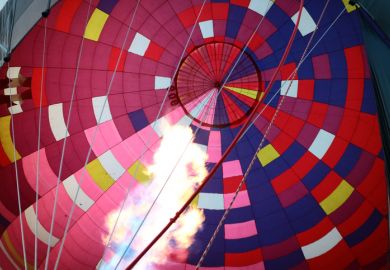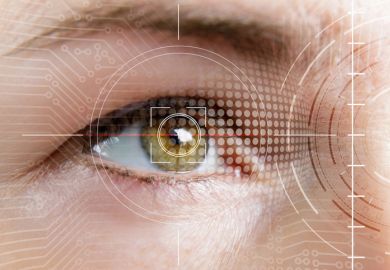What might neuroscience, the study of the nervous system including the brain, mean for how we educate students? That’s a question neuroscientists have been grappling with for a long time – and for a long time the answer has often been thought to be: “Not much, because we can’t scan everyone’s brain.”
But the authors of a recent paper think they have hit on something new, with implications for how neuroscience could be implemented to improve teaching in universities.
A team of scientists including Georgetown University researchers, in a National Science Foundation-funded study published in Science Advances, found that observing neural changes in a group of high school students via MRI scans predicted their ability to transfer spatial cognition learning into improved verbal reasoning – and predicted it better than standard assessments of their spatial cognition alone.
This isn’t the route to a future in which university students will effectively be reduced to pulsing brains in jars, getting scanned at the end of their course to decide their degree mark. But by recording measurable neural change and linking it to learning transfer, the researchers think their findings could start to offer a path to a future in which MRI scans of students’ brains, on a limited scale, could aid curriculum development for all students.
As a teacher in a university, Adam Green, director of Georgetown’s Lab for Relational Cognition and senior author on the paper, alongside Georgetown doctoral student Robert Cortes, who was lead author, said he has long been “interested in the ways curricula can be improved and to get at the development of curricula that give students not just the…rote level memorised content that we speak at them, but develop resources that are more generally, flexibly applicable”.
That kind of “learning transfer” – the application of specific knowledge to other or wider concepts – is the holy grail of so much university teaching.
The paper studied the use of “spatial education” – in which “students construct and evaluate spatial representations (maps) of real-world geographical datasets using geographic information systems technology” – in five public high schools in northern Virginia that in 2005 adopted “a spatially enriched geoscience curriculum”, which is known as the “Geospatial Semester” (though it’s now taught over a full year).
There’s debate in philosophy and psychology over the premise that spatial cognition underlies verbal reasoning. This idea, mental model theory, holds that when we’re reading and working with words, we’re relying on resources that our primate ancestors evolved to navigate the spatial world, then building spatialised representations of the verbal information.
So the researchers looked at the spatial regions of the students’ brains, scanning them before and after the class, to see whether students with more changes in the spatial parts of the brain were more likely to apply that to verbal reasoning and show improved performance in that field.
“We scanned them with fMRI – functional magnetic resonance imaging – which is the same kind of technology many people would have used to get a scan of their knee, their shoulder [in the event of an injury],” said Dr Green, provost’s distinguished associate professor at Georgetown.
“But in this case the technology is used to track blood flow in the brain as an indicator of where brain activity is.”
What the researchers found was that “neural changes predicted and mediated learning transfer”, they write in their paper, titled “Transfer from spatial education to verbal reasoning and prediction of transfer from learning-related neural change”.
The scans found changes in the spatial regions of the students’ brains and changes “in communication between those spatial regions and regions of the prefrontal cortex that are traditionally involved in lots of kinds of verbal thinking and reasoning”, said Dr Green.
“Those changes, when we compared them to not only grades and test scores, but also to changes in behavioural performance on spatial cognition tasks, were far more predictive of their transfer to verbal reasoning than any traditional scholastic or performance measure,” said Dr Green.
That emphasises when thinking about learning, he continued, just how much it is “worth looking inside, worth looking at what’s going on with change in the brain – that’s what learning is, it’s a change in the brain”.
In particular, it was significant that “the brain changes are more predictive of transfer”, that “index of deep learning, learning that goes beyond that memorisation of content”, he added.
That has potential wider implications.
“For a long time people have been puzzling over how, or whether at all, neuroscience is going to have anything of applicable value for classroom education,” said Dr Green.
There’s one very clear obstacle to the application of neuroscience in measuring learning: it’s too expensive and time-consuming to scan every student’s brain. Such an idea would be “implausible and tremendously unpleasant for everyone involved”, Dr Green observed.
Are there many researchers working on measuring the impact of education through brain scans?
There is study by neuroscientists of dyslexia or visual learning, for example, said Dr Green, but neuroscientific evaluation of learning itself through the “longitudinal difference between time points” is “almost never done” – making this study a rarity.
There are other researchers who have taken an MRI scanner to students’ brains. For example, in a paper published in Nature Communications last year, a group of Princeton University scientists tested their hypothesis that “learning is mirrored in neural alignment: the degree to which an individual learner’s neural representations match those of experts, as well as those of other learners”.
They did that by running “a longitudinal functional MRI study that regularly scanned college students enrolled in an introduction to computer science course” – showing students video recordings of lectures while they were in the scanner – finding that, indeed, “alignment among students successfully predicts overall performance in a final exam”.
That is “a really cool paper”, said Dr Green, but is “not the kind of thing that’s ever going to scale”.
More widely, “the goal can’t be to scale neuroscience to that massive, massive number of students that we educate” but instead “for it to operate at the level of curriculum development”, he argued.
Given that curricula are usually developed at relatively small scale, “if we can leverage these neural indices of change” to show “which ways of teaching are leading to the most robust changes”, teachers could “use that insight at the level of curriculum development”, he added.
As the paper puts it, “leveraging neural changes that predict transferability to enable neurally informed curriculum assessment thus has long-term promise as a means by which neuroscience may inform education by informing curriculum design (eg, by identifying existing curricula that are likely to achieve transfer, identifying changes to curricula that can improve transfer, and informing development of novel transferable curricula) while avoiding the practical and ethical limitations of large-scale neuroimaging (ie, by assessing curricula rather than individual students)”.
Dr Green stressed that while the study found MRI scanning of neural changes was “more predictive” than traditional assessment of learning transfer, “the best overall prediction comes from combining both of them [scans and assessment]. I don’t think this kind of work should ever be taken as saying: ‘OK, we can stop looking at…the more traditional ways of assessing learning.’ It’s just value that we can add to the ways we already assess learning.”
The researchers had a tough road on the study – it “took us about a year longer than we wanted it to run this study, because there were a lot of pragmatic challenges”, said Dr Green – but they have NSF funding for a further two related studies.
One, said Dr Green, will seek “to actually start scanning the teachers’ brains…looking at ways of teaching that lead to neural representations of concepts in the students’ brains that are the most similar to representations of those concepts in the teachers’ brains. And then looking to see whether that neural similarity between teacher and student, does that predict how well you retain a concept, how well and how flexibly you use that concept in the future?”
POSTSCRIPT:
Print headline: Want to get inside students’ heads? An MRI scan might help
Register to continue
Why register?
- Registration is free and only takes a moment
- Once registered, you can read 3 articles a month
- Sign up for our newsletter
Subscribe
Or subscribe for unlimited access to:
- Unlimited access to news, views, insights & reviews
- Digital editions
- Digital access to THE’s university and college rankings analysis
Already registered or a current subscriber?








